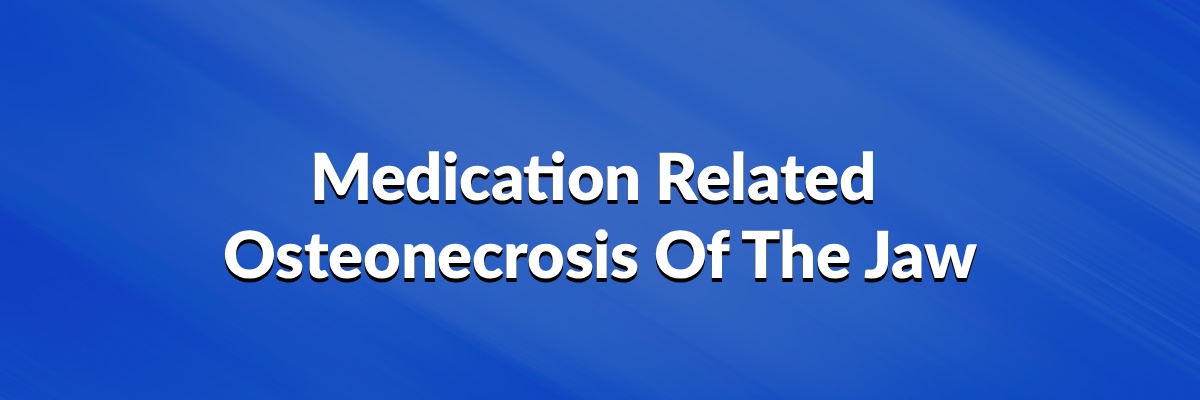Pathophysiology of MRONJ
- Proposed hypotheses that attempt to explain the unique localization of MRONJ exclusively to the jaws include
- Altered bone remodeling or oversuppression of bone resorption
- Angiogenesis inhibition
- Constant microtrauma
- Suppression of innate or acquired immunity
- Vitamin D deficiency
- Soft tissue BP toxicity
- Inflammation or infection
- Bisphosphonates (BP), and other antiresorptives such as denosumab, inhibit osteoclast differentiation and function, and increase apoptosis, all leading to decreased bone resorption and remodeling. Osteoclast differentiation and function plays a vital role in bone healing and remodeling in all skeletal sites, but osteonecrosis of the jaws only occurs primarily within the alveolar bone of the maxilla and mandible. An increased remodeling rate in the jaws may explain the differential predisposition to ONJ compared to other bones in the axial or appendicular skeleton.
- Angiogenesis is a process that involves growth, migration and differentiation of endothelial cells to form new blood vessels. Angiogenesis favorably influences tumor growth and also influences tumor invasion of vessels, resulting in tumor metastasis. Angiogenesis requires binding of signaling molecules such as vascular endothelial growth factor (VEGF) to receptors on the endothelial cells. This signaling promotes new blood vessel growth. Osteonecrosis is classically considered an interruption in vascular supply or avascular necrosis, and therefore, it is not surprising that inhibition of angiogenesis is a leading hypothesis in ONJ pathophysiology
MRONJ Staging & Treatment Strategies
| Staging | Signs & Symptoms | Treatment Strategies |
| At risk category | No apparent necrotic bone in patients who have been treated with either oral or IV bisphosphonates | • No treatment indicated
• Patient education |
| Stage 0 | No clinical evidence of necrotic bone, but non-specific clinical findings, radiographic changes and symptoms | • Systemic management, including the use of pain medication and antibiotics |
| Stage 1 | Exposed and necrotic bone, or fistulae that probes to bone, in patients who are asymptomatic and have no evidence of infection | • Antibacterial mouth rinse
• Clinical follow-up on a quarterly basis • Patient education and review of indications for continued bisphosphonate therapy |
| Stage 2 | Exposed and necrotic bone, or fistulae that probes to bone, associated with infection as evidenced by pain and erythema in the region of the exposed bone with or without purulent drainage | • Symptomatic treatment with oral antibiotics
• Oral antibacterial mouth rinse • Pain control • Debridement to relieve soft tissue irritation and infection control |
| Stage 3 | Exposed and necrotic bone or a fistula that probes to bone in patients with pain, infection, and one or more of the following: exposed and necrotic bone extending beyond the region of alveolar bone,(i.e., inferior border and ramus in the mandible, maxillary sinus and zygoma in the maxilla) resulting in pathologic fracture, extra-oral fistula, oral antral/oral nasal communication, or osteolysis extending to the inferior border of the mandible of sinus floor | • Antibacterial mouth rinse
• Antibiotic therapy and pain control • Surgical debridement/resection for longer term palliation of infection and pain |
Osteoradionecrosis
- Acute complications – A therapeutic dose of radiation in head and neck cancer usually comprises a total of 64–70 Gy in 32–35 fractions with the daily dose of 1.8–2.0 Gy/fraction. Acute complication appears 1–2 weeks after radiation starts, it depends on dose and site of radiation also.
- Oropharyngeal mucositis
- Change in salivary composition
- Alteration of taste (Dysgeusia)
- Infection (bacterial, fungal and viral)
- Periodontium pain
- Chronic complication:
- Trismus and fibrosis
- Malnutrition
- Osteo radionecrosis
- Dental caries
- Xerostemia.
Oral Mucositis
| Grade | Symptoms |
| Grade 0 | No oral mucositis |
| Grade 1 | Erythema and soreness |
| Grade 2 | Ulcers, able to eat solids |
| Grade 3 | Ulcers require liquid diet (due to mucositis) |
| Grade 4 | Ulcers, alimentation not possible (due to mucositis) |
Medication Related Osteonecrosis of the Jaw – 2022 Updates
Medication Related Osteonecrosis of the Jaw – 2014 Updates
Article – Medication Related Osteonecrosis of the Jaw – 2014 Update
Receiving antiresorptive therapy for osteoporosis
- For individuals who have taken an oral bisphosphonate for <4 years and have no clinical risk factors, no alteration or delay in the planned surgery is necessary
- For those patients who have taken an oral bisphosphonate for <4 years and have also taken corticosteroids or antiangiogenic medications concomitantly, the prescribing provider should be contacted to consider discontinuation of the oral bisphosphonate (drug holiday) for at least two months prior to oral surgery, if systemic conditions permit. The bisphosphonate should not be restarted until osseous healing has occurred.
- For those patients who have taken an oral bisphosphonate for >4 years with or without any concomitant medical therapy, the prescribing provider should be contacted to consider discontinuation of the antiresorptive for two months prior to oral surgery, if systemic conditions permit. The bisphosphonate should not be restarted until osseous healing has occurred.
Protocols for Patients on Antiresorptive Therapy
- The risk of developing MRONJ associated with oral bisphosphonates, while exceedingly small, appears to increase when the duration of therapy exceeds 4 years. This time frame may be shortened in the presence of certain comorbidities, such as chronic corticosteroid or antiangiogenic use. If systemic conditions permit, the clinician may consider discontinuation of oral bisphosphonates for a period of two months prior to and three months following elective invasive dental surgery in order to lower the risk of MRONJ. The rationale for this approach is based on extrapolated data that demonstrate fluctuations of osteoclast function, which is related to bisphosphonate therapy, and recent outcomes studies that show improved outcome of MRONJ treatment with drug cessation. The efficacy of utilizing a systemic marker of bone turnover to assess the risk of developing jaw necrosis in patients at risk has not been validated. Therefore the use of systemic markers of bone turnover as a measure of MRONJ risk is not recommended although the Committee supports continued research in this area.
Post-Operative Instructions
- Patients with osteoradionecrosis, it appears advisable that antiresorptive or antiangiogenic therapy should be delayed, if systemic conditions permit, until the extraction site has mucosalized (14-21 days) or until there is adequate osseous healing. Dental prophylaxis, caries control and conservative restorative dentistry are critical to maintaining functionally sound teeth. This level of care must be continued indefinitely.
- Patients with full or partial dentures should be examined for areas of mucosal trauma, especially along the lingual flange region. It is critical that patients be educated as to the importance of dental hygiene and regular dental evaluations, and specifically instructed to report any pain, swelling or exposed bone.







